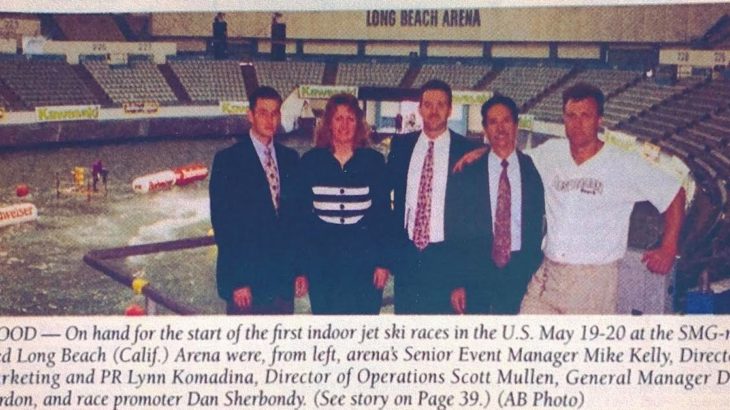Filling an arena bowl with water to create a pool suitable for racing jet skis is a challenge and a spectacle most venue managers just read about. Scott Mullen has done it — twice.
While neither event was successful financially, the PR factor and the public’s awed reaction made both experiences a treasured memory for Mullen.
The first attempt was at Long Beach Arena in 1995.
“We thought it would be cool to fill up the arena with water,” Mullen remembers of that risky booking. The cost was all on the promoter.
It required half a million gallons of water to fill the bowl. “We had to board up the doors and entrances to the arena bowl. Then the promoter put some vinyl liner and glued it and folded the seams. It didn’t leak too much. It was just like a big indoor pool,” Mullen said.
Teardown was a little more difficult. The city had concerns about the water, presumably tainted by jet ski fuel. Dumping that water into the parking lot meant it would flow into storm drains and into the ocean.
“They said no. We had to drain it into a sewer line. It took a long time to drain, at least 24 hours,” Mullen recalled.
The show in Long Beach drew 3,500-4,000 people. It didn’t make money. It was an expensive production. The city even charged the venue to dump the water in the drain.
But it was “great PR, interesting, something different. It got a lot of buzz,” Mullen recalls, which is probably why he agreed to do it again at iWireless Center, now TaxSlayer Center, in Moline, Ill., in 2009.
The promoter this time had even bigger plans. He envisioned taking the show on the road and, with that goal in mind, invited venue managers and promoters to the show. Included was Al Karosas, who managed the Bryce Jordan Center, University Park, Pa., and was supposed to get the next date, and Marty Bechtold, from Indianapolis. Mullen has witnesses.
“That show was a complete train wreck. The promoter was supposed to come in Monday, set the pool up early, and follow up with a week of publicity. We were going to have toy boat races so radio would come down and publicize it,” Mullen remembered. Instead the promoter came in late, delayed by engineering issues and manufacture of the barriers to put around the pool.
He never did truly promote the show. He came to Moline expecting to go to clubs and generate word of mouth to get tickets sold. Moline did not have a string of clubs like those he expected. So he went to strip clubs instead. “Bizarre,” Mullen said.
The pool showed up the day before the event. The promoter was filling it right up to the event. He used duct tape to attach it to the bleachers to hold it up. “That got wet and the liner started to fall,” Mullen recalled. And there was no bumper around the pool to contain the jet skis and make a track. There had been in Long Beach.
As described in the Quad City Times Sept. 19, 2009: Creating a 3-and-a-half feet deep pond that covers nearly the entire 31,000-square-foot floor of the i wireless Center starts with metal plates that stand 5 1/2 feet tall when set in place at a 45-degree angle. The liner is laid across the arena floor and over the metal plates creating the water-tight tank.
There was no one to really inspect that kind of thing, Mullen said. “He had an engineer help design it. It was structurally sound. But halfway through the event, one of the jet skis flew right out, into the seating area. It bounded off the railing and fell into the vomitory. The rider bailed off and stayed in the water.
“When he raised his hands up [to show he was okay], the crowd went crazy. That was the most exciting thing that happened.”
Fortunately no one was sitting in that seating section. It could have been disaster. Mullen had noted the angled barriers looked like an exit ramp to him, but the promoter was not concerned.
Mullen also observed that jet skis running around a still-water lake like the arena pond turn that pond into a whirlpool. “It’s sort of a washing-machine effect,” Mullen said. “The skiers were hanging on for dear life.”
The promoter again lost money. Only about 3,000 people attended. “And because of all the problems we had, no one took it on for future bookings. People were interested, but the show was a bust. It lost a total of $90,000.”
“It was just a rental, so it didn’t cost us in Long Beach. This one, we shared the expense with the promoter.”
Mullen does not regret taking the risk. He had seen it before and knew it had potential. “So we tried it, but never again.”
Lessons Learned:
• An arena pool event was risky, but worth a shot.
• Do not duct tape the liner to the bleachers.
• Make bumpers around the pool mandatory.
• Arenas are versatile. They can even be pools.
“It’s one of those things you never forget – to see people’s faces when they walked into the arena and saw it filled with water.” — Based on a true story as told to Linda Deckard
